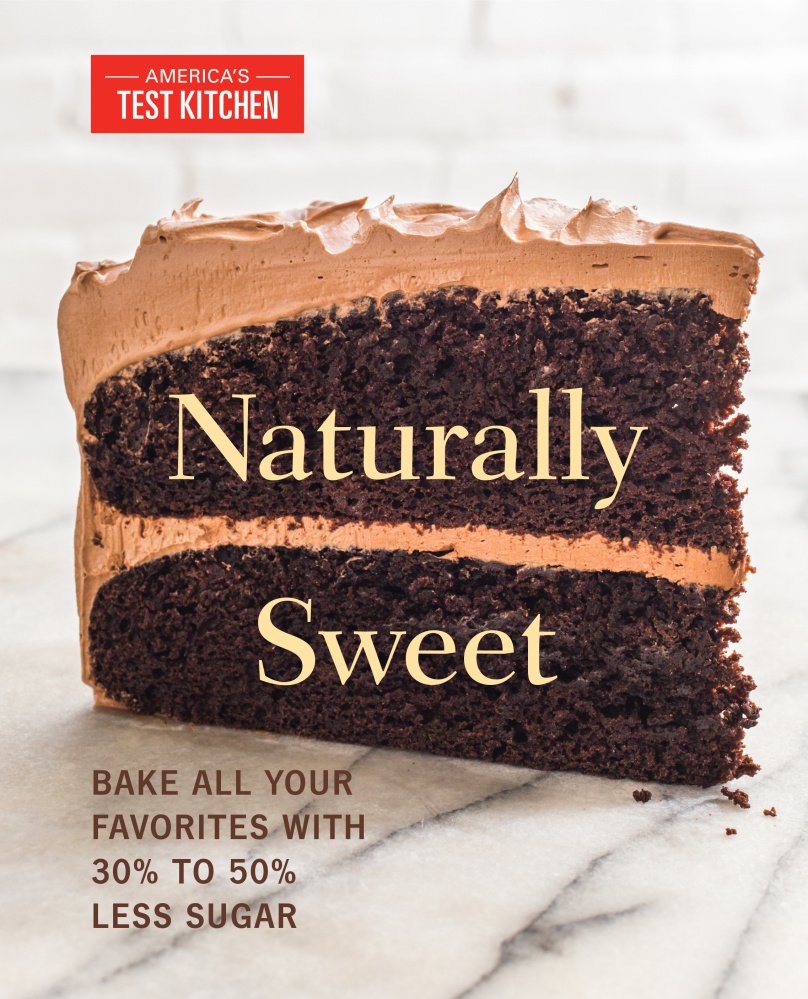“Naturally Sweet: Bake All Your Favorites with 30% to 50% Less Sugar.” America’s Test Kitchen. 336 pages. $26.95.
Sugar is the worst. That’s the word now in our world of health and nutrition. While that world has a tendency to seesaw enough to cause whiplash (anyone else remember eating more to weigh less 20 years ago in the Dean Ornish days?) sugar as bad guy sure seems credible in obesity-filled America. The U.S. Department of Agriculture even changed its guidelines in 2016, recommending we cut our sugar intake roughly in half. That would be from about 22 teaspoons of day to 12 teaspoons. We’re not talking teaspoons stirred into coffee either; sugar is an additive in many foods you wouldn’t expect (ketchup) as well as many you would (soda).
But sugar is also the best, right? It’s problematic. A family member gave up sugar (and gluten) more than a year ago and looks dazzling, but in my household such fortitude has proven difficult. Which is why I snapped up America’s Test Kitchen’s “Naturally Sweet,” with its promises of ways to “bake all your favorites with 30% to 50% less sugar.” Maybe moderation would be more manageable. And thanks to all those alternative offerings (from evaporated cane juice to Stevia and agave), the sugar aisle has become truly confusing,
The introductory sections of “Naturally Sweet” are filled with great explainers, including a graphic that shows just how refined sugar gets refined, including two stages of chemical “clarification.” It details why it doesn’t work for some recipes to say, simply half the amount of refined sugar (texture and moisture changes) and offers clear descriptions for the cellular differences between glucose, fructose and sucrose. The authors also explain why they ruled out some alternatives to classic granulated white sugar, such as Turbinado or Stevia, as good baking options. What we’re left to work with is Sucanat, coconut sugar, date sugar, maple syrup and honey. I bought the first two, grateful to finally understand that they are (Sucanat, available at my local health store, is made by “extracting the juice from sugar cane and then beating it with paddles to form granules” and coconut sugar, available at my local Hannaford, is “sap from the flowers of the coconut palm” boiled and beaten in a similar fashion).
“We set the bar pretty high for ourselves with this book,” the authors of “Naturally Sweet” write, and it shows in these sections. While I was disappointed that I had to go online to be reminded of the definition of “Dutch-processed cocoa” (seemingly for the 478th time in my life), everything else I needed was right there, delivered in a friendly tone and seriously informative; a chart that shows equivalent measures for granulated sugar, Sucanat and coconut sugar will be very handy for converting some of my own recipes. I was eager to see, no, to taste, what that bar looked like in food form.
I made three desserts, starting with a chocolate pound cake made with Sucanat, Dutch-processed cocoa powder and milk chocolate. It was bitter, a little dry and shockingly easy to resist. I threw a cocktail party and plopped the cake in the middle of the table full of finger food. The morning after, only one or maybe two slices had been taken. Fail. Then I made a rice pudding using local maple syrup (19 grams of sugar versus 32 grams in the original recipe). With some fresh fruit on top of it, I liked but didn’t love it. Next up, a dark chocolate pudding with Sucanat. The “Naturally Sweet” version of this pudding contained 20 grams of sugar, as opposed to 31 grams in the original recipe. No one is getting skinny on this – particularly not with that directive to stir 5 tablespoons of butter in at the end – but it was as delicious, easy to make and decadent seeming as any chocolate pudding I’ve ever had. I’m glad I baked on past that unsuccessful chocolate pound cake; this book might be a game changer for us.

Press Herald Staff Writer Mary Pols says the dark chocolate pudding is “as delicious, easy to make and decadent seeming as any chocolate pudding I’ve ever had.”
DARK CHOCOLATE PUDDING
Reviewer Mary Pols used Dutch-processed for the cocoa, half and half instead of heavy cream, and chocolate chips for the chopped chocolate because those are what she had in her pantry.
Serves 6
1/4 cup Sucanat
2 tablespoons unsweetened cocoa powder
2 tablespoons cornstarch
1/4 teaspoon salt
1/2 cup heavy cream
3 large egg yolks
21/2 cups whole milk
4 ounces bittersweet chocolate, chopped
5 tablespoons unsalted butter, softened
2 teaspoons vanilla extract
Whisk Sucanat, cocoa, cornstarch and salt together in a large saucepan. Add cream and egg yolks and whisk until fully incorporated, making sure to scrap corners of the pan. Whisk in milk until well combined and smooth.
Cook over medium heat, whisking constantly, until mixture is thickened and bubbling over entire surface, 5-8 minutes. Off heat, add chocolate, butter and vanilla and whisk until melted and smooth.
Strain pudding through fine-mesh strainer into bowl, place lightly creased parchment paper against surface and refrigerate until cold, at least four hours. Whisk pudding until smooth before serving.
Send questions/comments to the editors.



